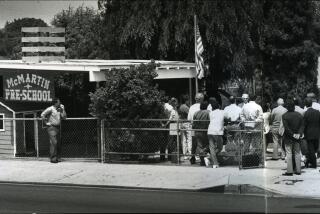Chamberlain Family Carries on Fight Years After Dingo-Baby Case
- Share via
SYDNEY, Australia — Early in August, 1980, a Seventh-day Adventist pastor, his wife and three children locked up their house in the Australian mining town of Mt. Isa and headed west for a vacation.
Michael Chamberlain had wanted to drive north to fish off the Northern Territory coast, but his wife Lindy persuaded him to spend a few days at Ayers Rock.
The decision was to cost their baby daughter, Azaria, her life and turn Lindy, who spent 3 1/2 years in jail for Azaria’s murder, into an international celebrity during one of the most bizarre criminal cases of recent times.
Ten years later, “Lindy” still means only one person in Australia.
Mention the case in a bar and half the people present are likely to insist there was no way a dingo could have dragged Azaria out of the Chamberlains’ tent at Ayers Rock and killed her as Lindy maintained in a series of inquests and trials.
Many Australians refused to see the 1988 film “A Cry in the Dark,” for which American actress Meryl Streep won an Oscar nomination for her portrayal of Lindy. They say the film was propaganda for the Chamberlains.
The family’s deeply religious background, the mystery and Aboriginal rites associated with Ayers Rock, and the fact Azaria’s body was never found led to wild rumors fueled by sensational media coverage.
Lindy’s outspoken defense and her refusal to be cowed by gossip or fierce questioning provoked suspicion in the Northern Territory, a rough, desolate, male-dominated part of the world.
Even to the most objective observer, her matter-of-fact explanation in a television interview at the time of how the dingo must have clawed and ripped her 9-week-old baby appeared unreal in its detachment.
Cleared by an initial inquest, Lindy was committed for trial in February, 1982, after a second inquest.
At the trial no motive was put forward for Lindy murdering her child, witnesses confirmed her version of events and key evidence by a British forensic scientist, who said Lindy had cut Azaria’s throat, was hotly disputed by the defense.
But in October, 1982, when seven months pregnant with daughter Kahlia, Lindy, then 34, was found guilty of Azaria’s murder and sentenced to life imprisonment. Michael was given an 18-month suspended sentence for complicity.
In February, 1986, a baby’s jacket, identified as Azaria’s, was found at the base of Ayers Rock and five days later Lindy was released from jail.
She was pardoned in June, 1987, after a Royal Commission, the sixth official investigation into Azaria’s death, said there were “serious doubts” about her guilt.
But the Northern Territory government refused to lift the convictions, and it was not until September, 1988, that an appeals court ruled that the Chamberlains had been victims of a miscarriage of justice and struck out the convictions.
The saga is far from over for the Chamberlain family. Lindy and Michael are seeking $3.2 million in compensation for personal hardship from the Northern Territory government.
Apart from their own harrowing experiences, the Chamberlains maintain that their children--they have two teen-age boys as well as Kahlia--will never be able to lead normal lives.
The family now lives near Newcastle on the New South Wales coast in a town that is a Seventh-day Adventist stronghold. Michael Chamberlain resigned from the ministry in January, 1984, and last year told journalists he was working as a woodcutter.
The family is also claiming $1.2 million in legal costs in order to repay their church, which supported them throughout their ordeal.
The Chamberlains issued a statement recently saying they had totally lost confidence in the Northern Territory government, which they accused of prolonging the compensation case.
The government had demanded details of the family’s financial position, which the Chamberlains insisted was irrelevant, and questioned the size of the claim for legal expenses.
The Chamberlains rarely appear in public. Lindy is working on her autobiography, called “Through My Eyes,” which was due for release on the 10th anniversary of Azaria’s death but has been delayed until October.
It will provide one of Australia’s most famous women with her best opportunity to put forward her case.
But whatever she writes, she is unlikely to influence those skeptics who still find it hard to believe her scream of Aug. 17, 1980: “The dingo’s got my baby.”
More to Read
Sign up for Essential California
The most important California stories and recommendations in your inbox every morning.
You may occasionally receive promotional content from the Los Angeles Times.












